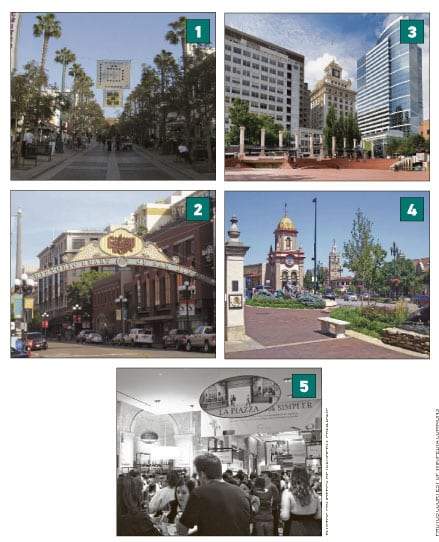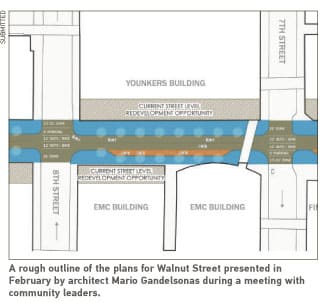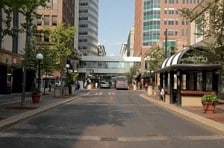Breathing life back into Walnut Street
What will it take for downtown developers and planners to revive its pulse?

This November, DART Central Station will open, driving out the buses and the transit mall that have occupied most of Walnut Street for the last 30 years.
With the buses gone, the street, which is downtown’s only two-way route running east-west, will once again be open to traffic.

“We’ve been telling drivers not to come here for the last 25 years. Retail in the core has pretty much died,” said Lyons, president and CEO of the Downtown Community Alliance (DCA).
Currently, the DCA is in the process of putting together a team consisting of a retail consultant, art and transportation consultants, an engineer, and two local architecture firms that will draw up plans for what the street will look like. It is also conducting focus groups to see what types of retail establishments would be able to keep a strong pulse in the heart of downtown.
The team will present a final concept and cost plan at year’s end, and then the real work of building the street and reshaping downtown residents’ opinions will begin.
RELATED STORY: The history of Walnut Street
“What exactly it’ll look like, we’re not sure,” Lyons said. What he does know is that Walnut Street will have wider sidewalks, more restaurants and retail options, and some type of art component that planners hope will creatively combine light and technology.
The street, flanked on either side by large buildings that once housed some of Des Moines’ major employers, are now mostly empty. In an effort to save the old, obsolete buildings, several, like the Fleming Building and the Crane Building, are being turned into chic urban apartments that will also offer street-level shops and cafes.
However, it’s the size of the buildings that poses one of the bigger challenges the revitalization effort is facing.
“Restaurants will come first, but the question is what will follow?” Lyons said. “We’re not going to find 100 tenants all at once … but once you get the interest going, the momentum will follow.”
Colleen Johnson, vice president of CBRE/Hubbell Commercial, agreed.
“Retailers don’t lead the way; they follow the crowd,” she said. However, Johnson has little doubt that the real estate agency, which owns and operates the skywalk-level Kaleidoscope at the Hub, will be able to start filling the street-level shops once there are more concrete plans.
“It’s important that office properties are filling up again, and the residential trend line needs to be increasing for retailers to return to Walnut Street,” she said, bringing up another challenge: luring retailers back to an area whose only current inhabitants are a Burger King restaurant and a Walgreen Co. pharmacy. “Retailers have their own set of criteria and we need to figure out how to attract the right kind of mix.”
The migration of downtown’s retailers happened gradually over the past century but was hurried along in the 1980s.
Cities battled for federal funds that would cover the majority of the cost for public transit centers. Des Moines chose Walnut Street as the public transit center’s home because so many large companies were located there. At the time, leaders thought this project would help retail, which had generally moved out or up off the ground level into the newly created skywalk system.
“They were very naive,” Lyons said. “Everyone was excited with what they were doing, but no one understood that retail lives and dies by accessibility.”
Lyons should know; he helped with a similar project while he was the executive director of Calgary’s Downtown Association. The Alberta city’s Stephen Avenue faced a fate similar to Walnut’s, but when plans to add a transit mall there failed in the 1980s and 1990s, he said he was able to turn the street around by “taking it apart and putting it together again.”
“You don’t copy what you did with these things,” Lyons said. “You learn from them.”
Looking at such projects as the Third Street Promenade in Santa Monica, Calif., and Pioneer Square in Portland, Ore., Walnut Street’s developers and planners have scoured the country for inspiration and ideas, tailoring and scaling them to fit Des Moines’ demographics and size.
But even more than finding businesses and other tenants to fill the floors of the office buildings, leaders hope the street is able to find its own unique character.
“We’re interested in what the downtown population wants,” Hubbell’s Johnson said, adding that it’s high time Walnut Street received this kind of attention. “All of our neighborhoods have a distinct personality; we’re anxious to see what Walnut Street’s personality will be.”
Given its prime location between Western Gateway Park and the Court District, Lyons envisions Walnut Street bridging the two together while also offering downtown commuters and urbanites alike another entertainment option.
“To be successful, we need a couple thousand Central Iowans to say, ‘Let’s go to Walnut Street on Friday or Saturday night,’ or we need people to say after work, ‘Let’s go to a happy hour,’” he said. “Or when people ask you where you work or live, and you say ‘Walnut Street,’ they’ll smile rather than grimace.”
Sources of inspiration
In order to plan Walnut Street’s transformation, the Downtown Community Alliance (DCA) looked at different types of public spaces for inspiration. However, tailoring the ideas to fit Des Moines’ size and demographics is just as important as the ideas themselves, leaders said.
1 Third Street Promenade, Santa Monica, Calif.
Spanning 30 city blocks and lined with palm trees illuminated by purple and green lights, this street in the heart of downtown is filled with shops as well as dining and entertainment options. DCA President and CEO Glenn Lyons said this is a good example of what Walnut Street could be.
2 Gaslamp Quarter, San Diego, Calif.
The city’s premier entertainment district, with more than 200 restaurants, comedy clubs, bars and nightclubs, and boutiques. Like Walnut Street, the Gaslamp Quarter’s retailers left the area until it was redeveloped in the 1970s and 1980s thanks to a joint urban preservation effort by business and property owners.
3 Pioneer Courthouse Square, Portland, Ore.
The urban park hosts more than 300 events each year, attracting more than 26,000 people each day. Lyons said Walnut Street acts as the linear strip next to the square, Nollen Plaza, but it is important to look at venues of different shapes and sizes.
4 Country Club Plaza, Kansas City, Mo.
The upscale shopping district and residential neighborhood stretches four miles long. The area is home to shops like Tiffany & Co. and Kate Spade New York as well as hotels and offices.
5 Eataly, New York City
Dedicated to all things Italian, this “megastore,” which is housed in an old factory building, is composed of an open market, upscale grocery store, restaurants and a food education center that holds cooking classes and wine tastings.

Project plans
Altering Walnut Street’s appearance and residents’ opinions will be a long process. Downtown Community Alliance (DCA) President and CEO Glenn Lyons is the first to point out that even he is unsure what the street will look like when it is finished. “We don’t just want it to be a pretty street,” he said. “It has to attract people and hold their interests.” However, there are some basic first steps that the DCA and the city of Des Moines have decided upon. After the plans are drawn up in January, a project timeline as well as who will pay for what must be decided. “I think it will be a mix of the city, the property owners on the street, and for the art – the philanthropists,” Lyons said.

Widen the sidewalks.
Add street parking.
Landscaping and seating.
Major art component. The DCA has contacted local artist James Ellwanger to look into interactive light art projects. Something as small as illuminating trees or a bridge can change the whole feel of the street, said Amy Baker, marketing and public relations director for the DCA.
Contract out space for street cafes and other businesses on the ground level.
Add retail to the bottom floor of renovated apartment buildings.










